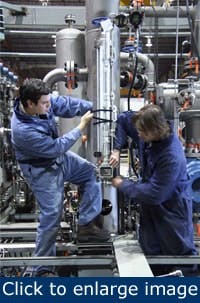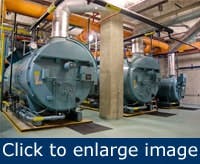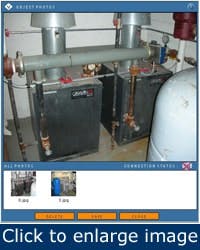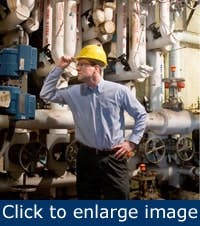Boiler breakdowns can cost thousands of dollars in equipment repairs as well as hundreds of thousands of dollars in property damage and business income losses. Boiler accidents also can cause loss of life and major structural damage to plants, facilities and equipment. When compared to a single instance of an unplanned plant shutdown, the cost of boiler inspection, maintenance and repairs is minor.
Proper boiler maintenance, servicing and inspection is not only a safety issue, it also can be a significant economic matter. Boiler downtime might force manufacturing plants to shut down plant operations and the production process, and every hour that production is stopped can cost hundreds of thousands of dollars.
No plant owner wants emergency shutdowns or equipment downtime, and the plant manager doesn’t want to be responsible if it occurs because boilers (or other equipment) weren’t serviced, inspected or maintained properly.
While boiler safety devices are designed to prevent dangerous conditions from turning into disasters, only proper boiler maintenance prevents the development of dangerous operating conditions in the first place. The only way the plant manager can be confident that control or safety devices are functioning properly is by regularly performing required maintenance, testing and inspection.
Regular inspection of boilers is the law, most often governed by the state, but in some cases governed by municipality and city. Boilers must be inspected by certified inspectors according to a mandated schedule. The day-to-day maintenance and service of boilers is the responsibility of plant engineers or plant managers. It’s important to remember that most problems don't occur suddenly. Instead, they develop slowly over a long period of time. So slowly, in fact, that the maintenance staff can grow accustomed to the change without realizing it has taken place.
Additionally, regular boiler inspections are important for optimal function and energy efficiency. Boilers are voracious energy users. Inefficient operation means wasted energy and increased operating costs.
Regular inspections also can extend the life of the vessel. As every plant owner and manager knows, industrial boilers are a major investment, costing upwards of $200,000.
Key boiler safety features
Boilers have a variety of safety features designed to prevent accidents and keep them functioning at optimal efficiency.
The ability of a safety valve to perform its intended function properly can be affected by several things, including internal corrosion or restricted flow. Internal corrosion typically is the most common cause of “freezing” or binding of safety/relief valves. This is generally caused by slight leakage or “simmering” caused by an improperly seated valve disk and is a condition that must be corrected immediately. It’s never recommended that a boiler be operated too close to the safety valve setting because the set pressure can cause these valves to leak slightly, resulting in an internal corrosion buildup that eventually prevents the valve from operating.
Water level control and fuel cutoffs perform two separate functions, but sometimes are combined in one unit. They provide both a water level control function and a safety feature of a low-water fuel-cutoff device. It’s important to ensure that piping is open and free of scale or sludge buildup at all times. Properly installed piping uses cross tees to enable easy cleaning and inspection. Low-water fuel cutoffs should be checked periodically for proper operation. Because this test requires allowing the boiler water to go to the minimum safe operating level, qualified personnel should use extreme caution when doing this.
The water gauge glass on a boiler enables the operator to observe and verify visually the actual water level in the boiler. If not properly cleaned and maintained, the sight glass might show there is sufficient water when the boiler is actually operating in a low water condition. A stain or coating sometimes develops on the inside of the glass where it’s in contact with boiling water, and this stain can give the appearance of adequate water in the boiler, especially when the glass is either completely full or empty of water.
It’s important that you regularly observe and check on the status of a variety of boiler components. Some basic and general tips include:
- Test for proper functioning of controls, including the pressure gauge, low-water cutoff devices, thermometers, temperature controls, gauge glass, and pressure relief valve.
- Test drains and blowoffs to ensure they’re functional.
- Check the fuel system for leaks and ensure that fuel filters and strainers are replaced regularly.
- Ensure that shut-off valves are leak-tight. If unsure, perform a leak tightness test.
- Ensure that the valves in instrument lines are functioning properly.
- Open the boiler vent valve or top tri-cock to vent air and fill the boiler with treated water to its proper level. Check that the expansion tank is properly filled.
- Verify that vent valve on gas-fired boilers is operating as required and that the vent isn’t clogged.
- Verify that the flame scanner or sensors are properly connected and functioning.
- Check instruments and safety devices for proper setting. Ensure that the water pressure regulator functions as required.
- Ensure the recirculation pump works as required.
- Confirm that there are no signs of overheating, corrosion or erosion.
- Check that heating system isolation valves are functioning properly.
- Verify that there are no leaks from any part of the boiler or external piping. Have a qualified contractor repair cracked surfaces immediately. Bulges or other deformities indicate defective controls or safety devices, or improper burner operation.
- Test safety valves on a regular schedule. Replace leaking safety valves.
- Inspect low-water fuel cutoff control for proper sequence and operation. Verify that it shuts off the fuel supply to the boiler as required.
If necessary, replace the glass even if the boiler must be shut down to do so. It’s also crucial to perform periodic maintenance of the piping leading to the glass gauge. The piping can become clogged and should be cleaned and inspected regularly to avoid false water level readings.
Stack temperature gauges monitor the temperature of the flue gas leaving the boiler. A high stack temperature indicates that the tubes might be developing a buildup of soot or scale. Also, the baffling inside the boiler might have deteriorated or burned through, allowing hot gases to bypass heat transfer surfaces in the boiler.
The fuel system, particularly the burner, requires periodic cleaning and routine maintenance. Failure to maintain the fuel system in good working order could result in excessive fuel costs, loss of heat transfer or even a boiler explosion.
Boiler log records are probably the single best method to ensure a boiler is getting proper maintenance. The boiler logs provide a continuous record of the boiler's operation, maintenance and testing. Because operating conditions change slowly over time, a log is the best way to detect significant changes that might otherwise go unnoticed. The success of any boiler log is determined by how vigilant the operator is in regularly updating it.
Efficiency and performance tips A boiler accounts for a large amount of a plant’s energy budget, and even a small decrease in a boiler’s efficiency can cause a sharp increase in energy costs. Several key factors influence the efficiency of boiler heat generation:
Optimal air-to-fuel ratio is important because a boiler requires just the right amount of oxygen to ensure efficient combustion. Excess air consumes energy because it’s being heated unnecessarily, which, in turn, wastes energy because the heated air is released up the stack. If there’s too little air, not all the fuel burns and this also wastes fuel. The unburned fuel continues to move through the system and leaves behind soot. Additionally, too little air might cause a build up of carbon monoxide and smoke.
To measure the ratio, you can use a computer-based distributed control system (DCS), which automatically controls the fuel burner to reduce oxygen levels as needed, optimizing the air-to-fuel ratio.
Water treatment is needed before feedwater can be pumped into a boiler. The impurities in raw water might cause corrosion or sediment buildup, both of which reduce efficiency. Impurities lead to wasted energy because they necessitate routine blowdowns. The cleaner the water supply going into the unit, the fewer blowdowns you’ll need.
Clean boiler heat transfer surfaces to remove the soot buildup that acts like an insulator and diminishes the efficiency of heat transfer between combustion gas and steam generation.
Heat loss from a boiler can waste a huge amount of energy. To minimize heat loss, install an economizer to recover waste heat from the stack. The heat can then be directed to the boiler feedwater for preheating. However, be sure to have the boiler system cleaned and tuned before installing an economizer so that an accurate measurement of stack gas temperature can be taken. Additional heat can be extracted from the flue gas (below 300°F) by use of a condensing economizer.
Condensate recovery from steam traps can be collected and reused as feedwater. This reduces boiler operating costs and usually is more cost-effective than using fresh utility water. It takes less fuel to convert recovered condensate into steam than fresh utility water, which is much cooler in temperature. The temperature of recovered condensate is high (160ºF to 200ºF), whereas the fresh water temperature usually doesn’t exceed 80ºF.
Boiler inspectors can educate you
Ask your boiler inspector for more information about how your boiler works and tell them about any problems you’re experiencing. Their extensive knowledge and practical experience can help you learn everyday procedures to ensure a long lifespan and safe vessel operation.
Stephen Kleva is CEO and president of Insparisk, LLC in Glendale, N.Y. Contact him at [email protected] and (888) 464-6772.





